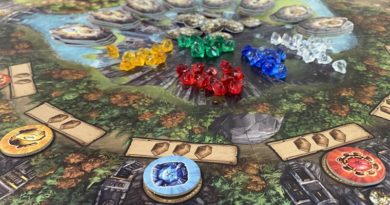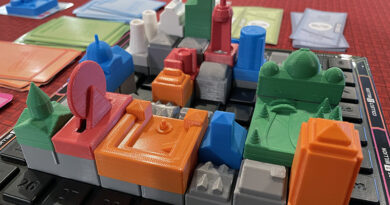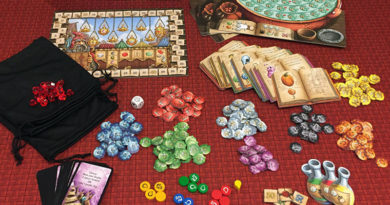Silver Card Game Review
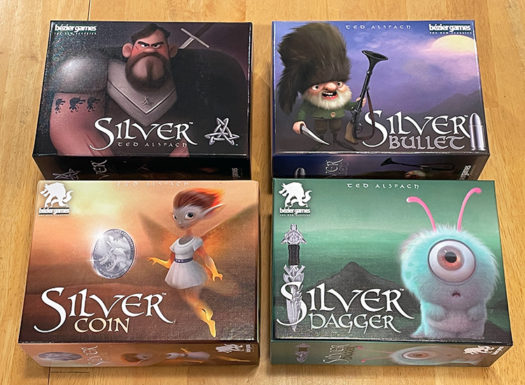
When everyone you introduce a new game to starts buying their own copies, you know you have a hit game on your hands.
Such has been the case for us with the card game Silver!
It’s a card game with a mix of hidden information, memory, strategy, luck, variable character abilities, and fun artwork that has us playing it over and over.
Plus, the expansions Bezier Games has published for it makes it infinitely replayable.
How to play Silver
The objective in a game of Silver is to finish with the lowest score over 4 rounds. Players gain points each round based on the value of cards remaining in their “village” when the round ends. So essentially players are trying to get rid of their cards (and especially their higher point cards) before a round ends.
The catch is that all cards in a player’s village start face down and players will only be able to look at their cards if an ability during the game lets them do so.
The cards are numbered from 0 to 13. There are two 0’s, two 13’s, and 4 of every other number.
Every card type has a unique ability that’s activated depending on how it’s used. Numbers 1 through 4 are active when they’re face up in a player’s village while numbers 5 through 12 are activated when discarded from the draw deck. And numbers 0 and 13 have their own unique abilities.
Set up
After shuffling the full deck of cards, players are each dealt 5 cards face down in a row as their village. The deck is placed face down in the center of the play area and 1 card is flipped over to start the discard pile.
That’s it – you’re ready to play.
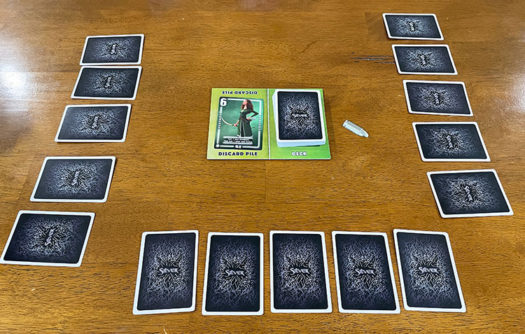
Game play
Each round, play begins with the player who scored the lowest points in the prior round. For the first round, players can choose who goes first.
At the start of each round, players choose 2 of the cards in their village to secretly look at. Players are not allowed to look at any other face down cards during the game unless an ability lets them do so.
On a player’s turn, they can one of the following:
- Draw a card from the top of the deck.
- Take the top card from the discard pile.
- Call for a vote
Top of Deck:
If a player draws from the top of the deck, they secretly look at the card and choose either to 1. place it face up on the discard pile and use its discard ability; 2. place it on the discard pile and do nothing; or 3. swap it with a card/s in their village.
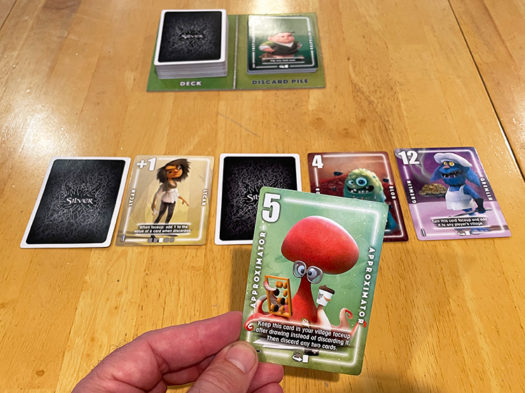
Discard Pile:
If a player draws from the discard pile, they may only swap it with card/s in their village.
Swap: When adding it to a village, a card is played into the village with the same facing as when drawn. Meaning if it was drawn face down, it comes into their village face down. If drawn face up (from the discard pile), it will come into their village face up. In doing so, the player chooses a card from their village to discard. Thus the swap. If the card they discard from their village has a discard ability, it does not activate. Those types of cards only activate when discarded immediately after drawing from the deck.
Swapping Multiple Cards: When swapping, a player may also choose to swap a drawn card with multiple cards from their village – as long as the multiple cards they discard are the same value card (ie. discard two 6’s). When swapping, the discarded card/s are placed face up on the discard pile. If the discarded cards do not match (for example, they were face down and the player discarding them thought they were the same number, but then discovers they were wrong), the player puts them back in their village (with the same orientation) as well as the card they drew that turn (plus more if they tried to swap more than 2 cards).
Call for Vote:
The other option a player has on their turn is to Call for a Vote. In doing so, this is the only thing they do on their turn – they don’t draw any cards, nor do they use any abilities on their face up cards.
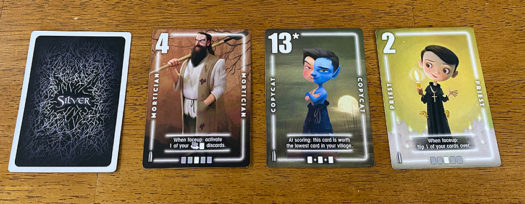
Calling for a vote signifies the last turn of the round. Each other player gets one final turn. Then all players reveal all the cards in their village and add up their points. If the player who called for a vote ends the round with the lowest points, they score 0 points for that round and get the silver Amulet for use in the next round.
If the player who called for a vote does not have the lowest points that round, they score the value of all of their cards plus a 10 point penalty.
The silver Amulet may be used to protect a card in that player’s village. It can’t be viewed or moved by any player for the rest of the round. The card will still score in the final tally for that round. And if the card is face up when the amulet is placed on it, the face up ability (cards 1-4) may still be used.
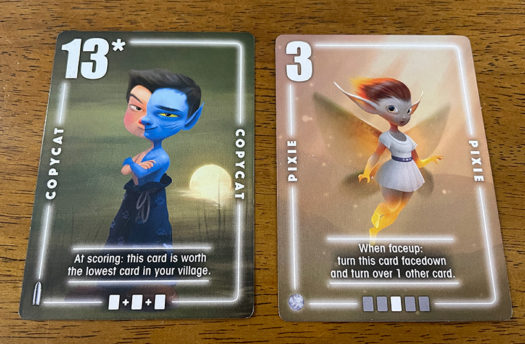
The other way a round may end is to run out of cards in the draw deck. The game immediately ends and players likewise tally the points from all the cards remaining in their villages. In this case, no one gets the silver Amulet.
Players use the score pad to record their scores each round. At the end of 4 rounds of play, the player with the lowest total score wins!
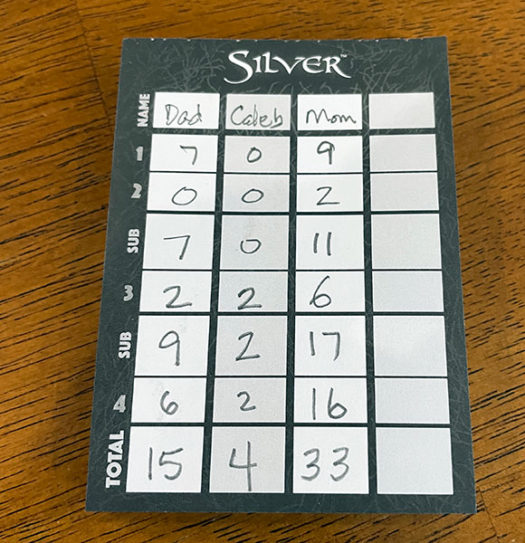
Can the whole family enjoy Silver?
As we said at the beginning, Silver has been a hit with everyone we’ve introduced it to. While we haven’t tried playing it with young kids yet, the 8+ recommended age feels right to us. We can see kids that age enjoying the game just as much. Plus, it will help them develop great memory skills.
And yes, kids younger than that may be able to pick it up and have fun playing, they’ll need to know how to read the abilities on the cards. However, players will also need to know more than just reading. That’s because it’s the way the cards interact with each other that brings out the beauty of the game. And you’ll have to judge if your kids will be able to pick up on that.
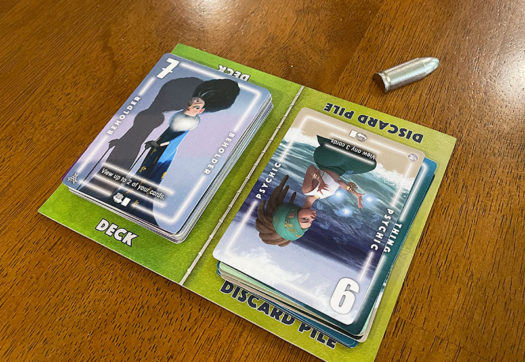
So why do we love Silver so much?
No doubt the artwork grabs our attention and pulls us in. However, it’s the game play itself that keeps us coming back to it again and again.
For starters, we love the hidden information. Not only are you trying to figure out which cards the other players have, you’re trying to do the same thing with your own cards!
It’s nice that you get to start each round by looking at 2 of your 5 cards. That at least gives you some information of what you may be able to do. But mostly the game will hinge on which cards you draw on your turn.
Well, which cards you discard will also play a pivotal role – because the player after you may be able to pick it up.
We love it when the player just before us discards a low valued card because that means we can take it into our village face up and immediately start using the ability.
And this can happen frequently because players will often discard one of their face down cards that they haven’t yet seen. And they’ll moan plenty when it’s a 0, 1, or 2 – while everyone else laughs.
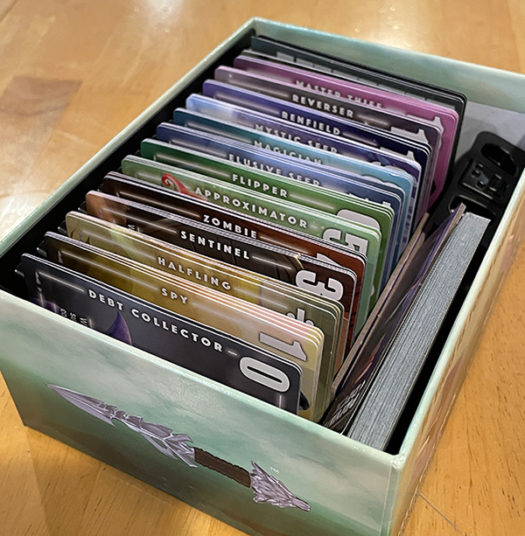
It also feels great when you can swap out multiple cards from your village. Since the winner is the person with the lowest score, whittling your village down to fewer cards is key. And doing so with lower valued cards is even better.
We also love the tension of deciding whether to call for a vote or not when you’re down to a few cards of low value. And that all depends on which set of cards you’re playing with. Because there are some cards in the expansions that add even more risk when calling for a vote – such as cards that let other players give you one of their cards, or swap one of your cards, or even flip your cards over that might hurt.
And that brings up another huge reason why we love Silver – the expansions!
The Joy of Expansions
The original game is officially, Silver Amulet.
The expansions then came out following alphabetical order: Silver Bullet, Silver Coin, and Silver Dagger.
I first played Silver Amulet at a friends house last year. Afterwards, I immediately added it to my game wish list.
Then earlier this year, I finally spent the $20 and picked up a copy of Silver Bullet – mainly so we could try a new set of cards.
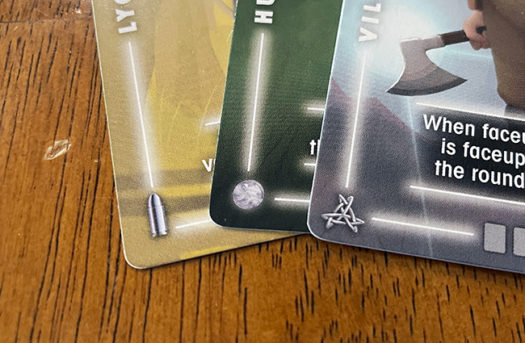
And just like the original, playing Silver Bullet was a blast. We played that a few times using just the cards in Bullet and loved it just as much. Then we started mixing the cards from each set.
Then we played it at work on a lunch break and more people got hooked. We knew they were immediately hooked because right after the game, they started talking about which of them would buy Silver Coin and which would buy Silver Dagger.
Now we keep a copy of each at the office and they get played regularly over lunch!
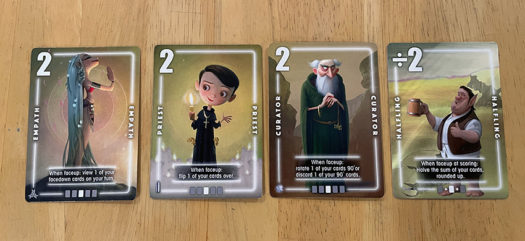
Every time we play, we mix up which cards we play with from the main game and expansions. While you have to play with only one type of card of each value (0-13), with expansions the possible combinations are endless.
It’s also fun having all those copies at the office because even more people can join in the fun.
While it’s a game that only up to 4 people can play, because we have the expansions, multiple groups of 4 can play over lunch – each with their own combinations of cards.
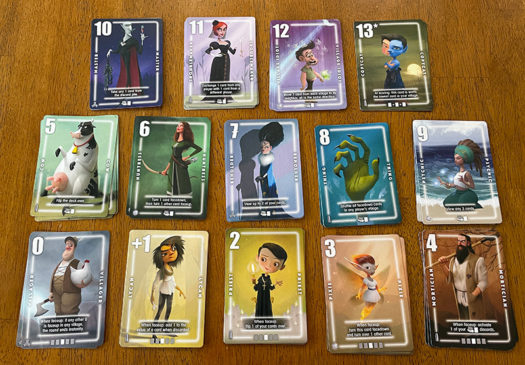
Which cards we play with will also determine the range of scores at the end of each round. Some mixtures of cards we’ve played with haven’t let us peek at many cards, so we’re playing more blindly in those games. Other times, we’ve played with card mixes that don’t let you flip many cards, so having face up cards in your village is rare – thus, missing out on using the powers of the lower cards.
But even in those odd games, we have a blast.
Since it’s such a light game, whatever the outcome, we’re usually laughing more about how we got there.
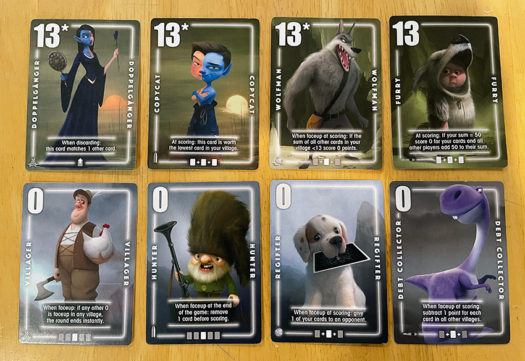
I could start mentioning some examples of fun cards that we love, but that list would then get too long.
You can see from the photos we’ve included in this review the types of abilities and potential combos there are. But we should also mention that the ability of the different items also differ with each expansion.
When a player calls for a vote and succeeds in having the lowest score that round, they get the item for use in the following round.
- Amulet: used to protect a card in that player’s village
- Bullet: used to eliminate a card from play
- Coin: used to flip over a card in any village
- Dagger: used to reverse play order
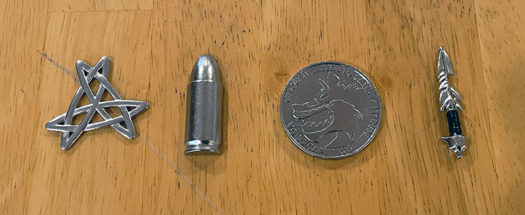
Another thing that’s great about the expansions is that the background colors of each of the numbers are similar. For example, all the 1’s have a yellow background, the 6’s have a green background, etc. And regardless of the expansion, all the cards numbered 1-4 have abilities when face up in your village and 5-12 have discard abilities. It’s a great way to keep the rules consistent while letting the unique actions of the cards bring in the variety.
I’ll end by saying that it hasn’t just been co-workers that rushed out and bought copies of Silver and the expansions. The same thing happened in our own family!
Our son Jaden bought Silver Amulet and Silver Bullet after playing them so he could play it with his friends. Since he graduated from college this year and is off on his own, he doesn’t want to have to borrow my copy – he wants them at the ready for his own game nights with friends.
And I totally support him in that decision – because I keep my copy at work since it’s getting played so much and then I ask him to bring his copies when we get together as family.
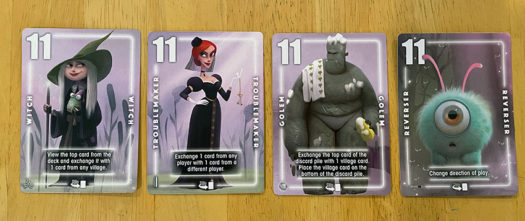
How does Silver score on our “Let’s Play Again” game meter?
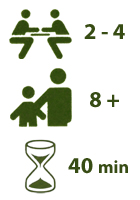 If you haven’t guessed already, Silver scores extremely high on our “let’s play again” game meter.
If you haven’t guessed already, Silver scores extremely high on our “let’s play again” game meter.
It’s getting played over and over in our family as well as at the office. The light nature of the game, simple set up, and quick player turns all help make it such a draw. But really it comes down to the fun mix of card abilities that make every game feel and turn out differently. We love that variety.
We definitely recommend you grab a copy of Silver and its expansions for playing with your family and friends.



